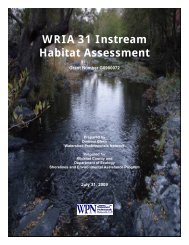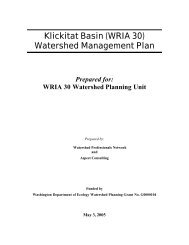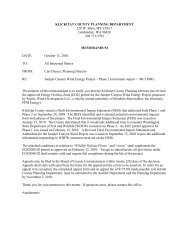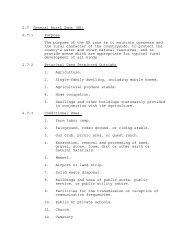Miller Wind Ranch Layout Revision Letter and HCP
Miller Wind Ranch Layout Revision Letter and HCP
Miller Wind Ranch Layout Revision Letter and HCP
- No tags were found...
Create successful ePaper yourself
Turn your PDF publications into a flip-book with our unique Google optimized e-Paper software.
Page 11 of 20WDFW <strong>and</strong> Klickitat County have recommended that construction activities occur to the greatestextent possible outside of the breeding season. However, to the extent that construction of thebridge or OH collector line must occur between May 15 <strong>and</strong> September 30, western gray squirrelnests within 400 feet of construction activities <strong>and</strong> 1,300 feet of blasting or pile driving will bemonitored before, during, <strong>and</strong> after construction activities by an independent qualified biologist.Should active nests be impacted by construction activities or operation of a conductor within 75feet of an occupied nest, mitigation options will be reviewed with Klickitat County <strong>and</strong> WDFW.Potential on-site mitigation options for the western gray squirrel include 1) protecting oak forests<strong>and</strong> prairie association from development; 2) retaining mast producing trees; 3) where previouslyremoved, replanting oaks <strong>and</strong> nut trees; 4) removing grazing for a period to allow oakregeneration, 5) installing nest boxes; <strong>and</strong> 6) road <strong>and</strong> squirrel hunting closures in priority habitatareas (Rodrick <strong>and</strong> Milner 1991). In addition, because a frequent source of mortality for westerngray squirrels is due to vehicular traffic, reduced speed limits may reduce the likelihood thatvehicles will kill squirrels on roads. Off-site mitigation options may also be reviewed withKlickitat County <strong>and</strong> WDFW as necessary <strong>and</strong> appropriate.Vaux’s swifts nest in forested habitat are more common in old-growth forests than in youngerst<strong>and</strong>s. The species usually roosts <strong>and</strong> nests in natural cavities with vertical entryways, such aslarge-diameter hollow trees or snags. The species often forages over woodl<strong>and</strong>s, lakes, <strong>and</strong>rivers, where flying insects are abundant. Suitable roosting, breeding, <strong>and</strong> foraging habitats forVaux’s swifts occur within the project area <strong>and</strong> surrounding habitats. Project design <strong>and</strong>construction should minimize impacts to forest <strong>and</strong> woodl<strong>and</strong> areas that serve as valuable habitatfor the Vaux’s swift.Western toads are found in a wide variety of habitats, ranging from desert springs to mountainwetl<strong>and</strong>s. They range into various upl<strong>and</strong> habitats around ponds, lakes, reservoirs, <strong>and</strong> slowmovingrivers <strong>and</strong> streams; sometimes they move up to several kilometers through upl<strong>and</strong>s, awayfrom breeding areas (Bull 2006). For shelter, they dig their own burrow in loose soil or useburrows of small mammals or seclude themselves under logs or rocks. Egg-laying sites includeshallow areas of ponds, lakes, or reservoirs, or pools of slow-moving streams. Western toadsoften overwinter underground in rodent burrows, under large rocks, logs or root wads, <strong>and</strong> inbanks adjacent to streams <strong>and</strong> lakes.Wood Gulch is a perennial stream that may be used by breeding western toads. In addition,overwintering habitat, such as rodent burrows, are abundant throughout the area. Constructionactivities may directly <strong>and</strong> indirectly impact potential wetl<strong>and</strong> <strong>and</strong> upl<strong>and</strong> habitats for thewestern toad in several ways, including killing migrating toads by vehicles on roads, degradinghabitat by causing habitat fragmentation, isolating populations by developing in wetl<strong>and</strong> buffers,<strong>and</strong> negatively impacting water quality <strong>and</strong> hydrology.It is recommended that appropriate erosion <strong>and</strong> stormwater pollutant control measures beimplemented, <strong>and</strong> that oversize culverts be installed at various locations along the access road tomaintain <strong>and</strong> improve wildlife movement through the Project area. Signs <strong>and</strong> traffic speedsshould also be implemented.In accordance with the Project EOZ Permit, a distance of 1,300 feet from any occupied raptornest is to be maintained between April 15 <strong>and</strong> August 31. Therefore, construction of the









